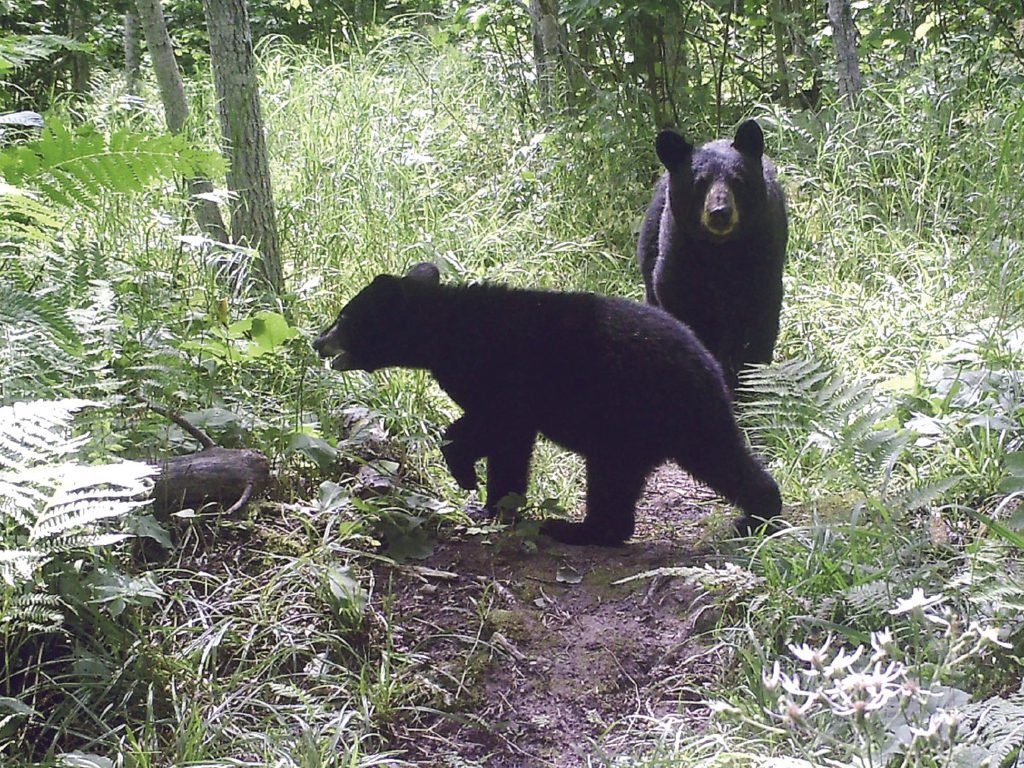TWO HARBORS—Drought conditions and poor production of berries and other wild foods has led to a surge of bear complaints along the North Shore this summer as hungry bears wander into backyards and rummage through dumpsters looking for something to eat. Minnesota DNR area wildlife manager Nancy Hanson passed along some information about the food conditions and how to discourage bears from causing problems for people.
In mid-August, Hanson said in an email, “My staff has been busy fielding calls and doing site visits on bear issues. North Shore conservation officers Mary Manning and Kylan Hill have been very busy with bear complaints this year. Jon Benson of the USFS in Tofte has tallied a lot of bear complaints from campsite users in the BWCAW too this year. The USFS put a Food Storage Order in place to help prevent bear problems at campsites.”
Generally, bear foods in general are better along the North Shore due to the lake effect, but not good farther inland. Hazelnuts are looking good, and raspberries improved late after the rains came. Due to the lack of natural foods, many bears have been attracted to garbage at residences, businesses and community dumpsters. Once they find a food resource, they will return to it.
Poor food production leads to more nuisance complaints. Along the North Shore, the DNR received a fair increase in nuisance complaints over last year, as hungry bears become increasingly bold in their quest
for food.
Folks plagued with bear problems may get some relief due to the upcoming hunting season. Bear baiting began Aug. 14 and bear hunting starts Sept. 1. Poor food production typically leads to higher hunting success, since over 90 percent of hunters use bait. Bears are more reliant on these baits when they are hungry and preparing for hibernation. The DNR has found two factors can reliably predict the bear harvest: the number of hunters and the productivity of three key fall foods—hazelnuts, acorns and dogwood berries. When fall foods are poor, hunting success increases.
Assuming food conditions remain the same into the fall, DNR biologists expect an above-average harvest (at least 2,400–2,600 bears) this year. Hunters can expect good success in areas food conditions are poor. Unfortunately, the harvest of reproductive females increases dramatically in poor food years. Older females are drawn into baits and shot at disproportionally high rates. If a large proportion of the 2020 harvest consists of reproductive females, this could depress the population growth rate for several years.
The sharp drop in the bear population 20 years ago, and its unexpectedly slow recovery (even with relatively low harvests) was, in part, caused by an excessive harvest of older females in a very poor food year in 1995. In recent years, the DNR issued fewer hunting permits to build the bear population so it would be more resilient during years with poor foods and above-average hunting harvests.
- Cameras Security and trail cameras allow folks to become aware of the wildlife on their property or near their homes’ including bears. The animals may have always been there, but now they are being captured on camera.
- Bear Spray Bear spray is highly recommended for BWCAW visitors, hikers, campers, and residents of the northern forest. Business owners (resorts, restaurants, stores, etc.) can have it on hand for staff and guests if bears frequent their property. Bear spray has pretty good range and works very well when used properly (be aware of wind direction).
- Garbage Garbage and poorly designed containers have been the biggest bear attractant this year. Many people have learned to put bird feeders away. DNR Wildlife staff can recommend better dumpster or garbage container designs. Even plywood, fence posts and ratchet straps can temporarily protect plastic lids on dumpsters until a replacement dumpster or metal lid is put in place. Properly designed electric fences work very well.
- Electric Fences Should be five or six strands of electric wire to be effective; two- or three-strand fences don’t work. Many options available now. Solar powered chargers keep fence charged. Gates and switches to turn off the fence make access easy for people. Signs should be used to warn people the fence is electrified. Fences work well at protecting fruit trees, bee hives, dumpsters, garbage cans, gardens, livestock, and compost piles. DNR Wildlife staff can recommend designs for that or there are many resources out there.
- Unwelcome Mats Both sharp or electric unwelcome mats can be used to keep bears from accessing certain areas (like front doors, garbage cans, sheds). Sharp mats can be designed with a hinge to fold shut and be safe when not in use.

